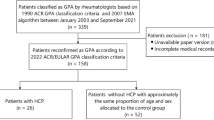Abstract
Objective
To explore the clinical and imaging features of patients with hypertrophic cranial pachymeningitis (HCP).
Methods
A retrospective study was performed on 22 patients with HCP diagnosed at the Affiliated Hospital of Xuzhou Medical University from February 2014 to September 2017.
Results
A headache was present as an initial symptom in 18 patients. The headache was associated with the loss of vision (2 cases), facial pain (1 case), and unsteady walking (1 case). Other symptoms included cranial nerve dysfunction (15 cases), cerebellar ataxia (4 cases), and sinus thrombosis (3 cases). In the laboratory tests, 7 patients showed an increased number of white blood cells, higher levels of C-reaction protein (CRP), and erythrocyte sedimentation rate (ESR). An elevated level of immunoglobulin G4 (IgG4) and the presence of the anti-neutrophil cytoplasmic antibody (ANCA) were found in 3 and 2 patients respectively. There were 17 patients who had abnormalities in their cerebrospinal fluid (CSF) on lumbar puncture. On magnetic resonance imaging (MRI), a local or generalized thickening was observed in the cerebral falx, the tentorium of the cerebellum, the fronto-parietal lobe, the occipito-parietal lobe, and the dura of skull base. A dural biopsy obtained in one case showed a variety of inflammatory changes. An immunohistochemical analysis revealed the positivity of CD138, IgG, and IgG4 in some cells. All 22 patients had a good response to corticosteroids.
Conclusion
HCP mainly leads to a headache and the paralysis of multiple cranial nerves. A biopsy and MRI are often required and serve as the basis for the diagnosis and effective therapy.


Similar content being viewed by others
References
Vale TC, Duani H, Macedo DL (2013) Cranial hypertrophic pachymeningitis secondary to neurocysticercosis. Neurol Sci 34:401–403. https://doi.org/10.1007/s10072-012-1002-4
Han F, Zhong DR, Hao HL, Kong WZ, Zhu YC, Guan HZ, Cui LY (2016) Cranial and lumbosacral hypertrophic pachymeningitis associated with systemic lupus erythematosus: a case report. Medicine (Baltimore) 95(39):e4737
Kaga H, Komatsuda A, Saito M, Nara M, Omokawa A, Togashi M, Okuyama S, Wakui H, Takahashi N (2018) Anti-neutrophil cytoplasmic antibody-associated vasculitis complicated by periaortitis and cranial hypertrophic pachymeningitis: a report of an autopsy case. Intern Med 57(1):107–113
Popkirov S, Kowalski T, Schlegel U, Skodda S (2015) Immunoglobulin-G4-related hypertrophic pachymeningitis with antineutrophil cytoplasmatic antibodies effectively treated with rituximab. J Clin Neurosci 22(6):1038–1040
Shimojima Y, Kishida D, Sekijima Y (2017) Increased BAFF and APRIL levels in the cerebrospinal fluid of patients with anti-neutrophil cytoplasmic antibody-related hypertrophic pachymeningitis. Cytokine 99:305–309
Shen Y, Dai T, Wu W (2016) The clinical diagnosis and treatment of hypertrophic dural inflammation. Chin J Intern Med 55(3):234–236. https://doi.org/10.3760/cma.j.issn.0578-1426.2016.03.018.
Lin Z, Zhang H, Dai L (2013) The clinical and imaging features of hypertrophic meningitis. A report of 13 cases. J Apoplexy Neuropathy 30(9):801–803
Russo A, Silvestro M, Cirillo M, Tessitore A, Tedeschi G (2017) Idiopathic hypertrophic pachymeningitis mimicking hemicrania continua: an unusual clinical case. Cephalalgia. https://doi.org/10.1177/0333102417708773
Della-Torre E, Campochiaro C, Cassione EB, Albano L, Gerevini S, Bianchi-Marzoli S, Bozzolo E, Passerini G, Lanzillotta M (2018) Intrathecal rituximab for IgG-related hypertrophic pachymeningitis. J Neurol Neurosurg Psychiatry 89(4):441–444
Zhou J, Yang Y, Chen S (2014) The clinical and imaging features of hypertrophic meningitis. Guangdong Med 10:1547–1548,1549
Hahn LD, Fulbright R, Baehring JM (2016) Hypertrophic pachymeningitis. J Neurol Sci 367:278–283
Huang K, Xu Q, Ma Y, Zhan R, Shen J, Pan J (2017) Cerebral venous sinus thrombosis secondary to idiopathic hypertrophic cranial pachymeningitis: case report and review of literature. World Neurosurg 106:1052.e13–1052.e21
Author information
Authors and Affiliations
Corresponding author
Ethics declarations
Conflict of interest
The authors declare that they have no conflict of interest.
Rights and permissions
About this article
Cite this article
Chen, H., Zhang, W., Jing, J. et al. The clinical and imaging features of hypertrophic pachymeningitis: a clinical analysis on 22 patients. Neurol Sci 40, 269–274 (2019). https://doi.org/10.1007/s10072-018-3619-4
Received:
Accepted:
Published:
Issue Date:
DOI: https://doi.org/10.1007/s10072-018-3619-4




